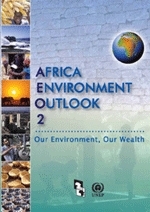From The Encyclopedia of Earth
Original Publisher: United Nations Environment Programme
Published: 2006
|
Introduction
Section 1: Environment for Development
Chapter 1: The Human Dimension
Section 2: Environmental State-and-Trends: 20-Year Retrospective
Chapter 2: Atmosphere
- Regional synthesis
- Sub-regional overviews
- Conclusion
Chapter 3: Land
- Regional synthesis
- Endowments and opportunities
- Challenges faced in realizing opportunities for development
- Sub-regional overviews
- Conclusion
Chapter 4: Freshwater
- Regional synthesis
- Sub-regional overviews
- Conclusion
Chapter 5: Coastal and Marine Environments
- Regional synthesis
- Sub-regional overviews
- ConclusionChapter 6: Forests and Woodlands
- Regional synthesis
- Sub-regional overviews
- Conclusion
|
Chapter 7: Biodiversity
- Regional synthesis
- Sub-regional overviews
- Conclusion
Chapter 8: Interlinkages: The environment and policy web
Section 3: Emerging Challenges
Chapter 9: Genetically Modified Crops
Chapter 10: Invasive Alien Species
Chapter 11: Chemicals
Chapter 12: Environment for Peace and Regional Cooperation
Section 4: Outlook
Chapter 13: The Future Today
- Introduction
- The Characteristics of Four Scenarios
- Driving Forces
- Regional scenarios
- Regional Scenario Narratives: Land
- Regional Scenario Narratives: Freshwater
- Regional Scenario Narratives: Atmosphere
- Regional Scenario Narratives: Coastal and Marine Environments
- Sub-regional scenarios
- Eastern Africa
- Central Africa
- Northern Africa
- Western Africa
- Western Indian Ocean islands
- Conclusion
Section 5: Policy Opportunities
Chapter 14: Back to Our Common Future: A Renaissance for the Environment
- Introduction
- Policy options for action
- The Human Dimension
- The Atmosphere
- Land
- Freshwater
- Coastal and Marine Environments
- Forests and Woodlands
- Biodiversity
- Genetically Modified Crops
- Invasive Alien Species
- Chemicals
- Africa's renaissance for the environment: environment for peace and regional cooperation
- Vulnerability of Small Island Developing States
- Policy Interlinkages
- Africa's renaissance for the environment: conclusion
|
